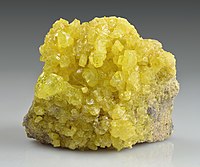
Photo from wikipedia
Strawberries (Fragaria × ananassa Duch.) are considered a functional food and pleasing fruit in China, mainly because of their high concentration of ellagic acid (EA) and their aroma. A total of 127… Click to show full abstract
Strawberries (Fragaria × ananassa Duch.) are considered a functional food and pleasing fruit in China, mainly because of their high concentration of ellagic acid (EA) and their aroma. A total of 127 volatile compounds were identified by HS-SPME-GC-MS. Changes in volatile constituents and EA were investigated in 50 strawberry cultivars in the red-ripening stage and in 6 cultivars, including 'Benihoppe', 'Snow White', 'Yanli', 'Kaorino', 'Tokun', and 'Xiaobai', at four developmental stages. The results indicated that the components and amounts of volatile compounds and EA markedly varied among and within cultivars. Through multivariate statistical analysis of the volatile compounds, 50 cultivars were divided into 4 clusters. Aromatic components that affected the cluster formation of cultivars were detected. Volatile compounds varied quantitatively among the 6 varieties during the developmental stages, and distinct changes were observed in both red-turning fruits and red-ripening fruits compared with white fruits. Except for 'Xiaobai', which showed the highest EA content at the red-ripening stage, the other 5 cultivars exhibited the highest EA level at the large green fruit stage. Partial least squares-discriminant analysis (PLS-DA) of the profiles of volatile compounds indicated that large green fruits were characterized by EA and aldehydes; white fruits were characterized by ketones and alkanes; and red-ripening fruits were characterized by esters, acids, furans, and alcohols. The results contribute new and important information to breeding programs and the desirable cultivation of strawberry production.
Journal Title: Food research international
Year Published: 2020
Link to full text (if available)
Share on Social Media: Sign Up to like & get
recommendations!